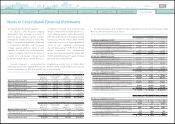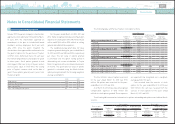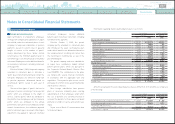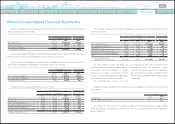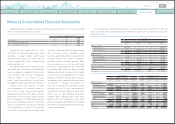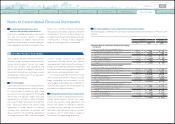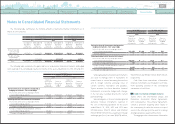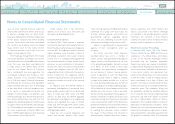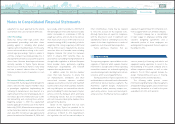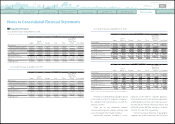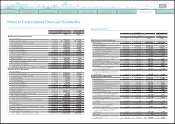Toyota 2012 Annual Report Download - page 107
Download and view the complete annual report
Please find page 107 of the 2012 Toyota annual report below. You can navigate through the pages in the report by either clicking on the pages listed below, or by using the keyword search tool below to find specific information within the annual report.
TOYOTA ANNUAL REPORT 2012
Toyota Global Vision Changes for Making
Ever-Better Cars President
ʼ
s Message Medium- to Long-Term
Growth Initiatives Special Feature Management and
Corporate Information Investor Information
Business and
Performance Review Financial Section
Notes to Consolidated Financial Statements
Derivative financial instruments: 20
Toyota employs derivative financial instruments,
including foreign exchange forward contracts,
foreign currency options, interest rate swaps,
interest rate currency swap agreements and
interest rate options to manage its exposure to
fluctuations in interest rates and foreign currency
exchange rates. Toyota does not use derivatives
for speculation or trading.
Toyota enters into interest rate swaps and interest
rate currency swap agreements mainly to convert
its fixed-rate debt to variable-rate debt. Toyota
uses interest rate swap agreements in managing
interest rate risk exposure. Interest rate swap
agreements are executed as either an integral
part of specific debt transactions or on a portfolio
basis. Toyota uses interest rate currency swap
agreements to hedge exposure to currency
exchange rate fluctuations on principal and
interest payments for borrowings denominated
in foreign currencies. Notes and loans payable
Toyota
ʼ
s U.S. subsidiaries provide certain health
care and life insurance benefits to eligible
retired employees. In addition, Toyota provides
benefits to certain former or inactive employees
after employment, but before retirement. These
issued in foreign currencies are hedged by
concurrently executing interest rate currency
swap agreements, which involve the exchange of
foreign currency principal and interest obligations
for each functional currency obligations at agreed-
upon currency exchange and interest rates.
For the years ended March 31, 2010, 2011 and
2012, the ineffective portion of Toyota
ʼ
s fair value
hedge relationships was not material. For fair
value hedging relationships, the components of
each derivative
ʼ
s gain or loss are included in the
assessment of hedge effectiveness.
Toyota uses foreign exchange forward contracts,
foreign currency options, interest rate swaps,
interest rate currency swap agreements, and
interest rate options, to manage its exposure
to foreign currency exchange rate fluctuations
and interest rate fluctuations from an economic
perspective, and for which Toyota is unable or
has elected not to apply hedge accounting.
The following table summarizes the fair values of derivative financial instruments as of March 31, 2011
and 2012:
benefits are currently unfunded and provided
through various insurance companies and health
care providers. The costs of these benefits are
recognized over the period the employee provides
credited service to Toyota. Toyota
ʼ
s obligations
under these arrangements are not material.
■
Postretirement benefits other than
pensions and postemployment benefits
■
Fair value hedges
■
Undesignated derivative financial instruments
■
Fair value and gains or losses on derivative financial instruments
Yen in millions
U.S. dollars in millions
March 31, March 31,
2011 2012 2012
Derivative financial instruments designated as hedging
instruments
Interest rate and currency swap agreements
Prepaid expenses and other current assets ¥ 55,794 ¥ 7,166 $ 87
Investments and other assets - Other 74,528 61,174 744
Total ¥ 130,322 ¥ 68,340 $ 831
Other current liabilities ¥
(
7,410
)
¥
(
2,060
)
$
(
25
)
Other long-term liabilities
(
1,188
)(
303
) (
4
)
Total ¥
(
8,598
)
¥
(
2,363
)
$
(
29
)
Undesignated derivative financial instruments
Interest rate and currency swap agreements
Prepaid expenses and other current assets ¥ 99,093 ¥ 61,983 $ 754
Investments and other assets - Other 185,272 157,642 1,918
Total ¥ 284,365 ¥ 219,625 $ 2,672
Other current liabilities ¥
(
64,611
)
¥
(
38,338
)
$
(
467
)
Other long-term liabilities
(
132,785
)(
120,666
) (
1,468
)
Total ¥
(
197,396
)
¥
(
159,004
)
$
(
1,935
)
Foreign exchange forward and option contracts
Prepaid expenses and other current assets ¥ 2,619 ¥ 9,531 $ 116
Investments and other assets - Other
—
̶
̶
Total ¥ 2,619 ¥ 9,531 $ 116
Other current liabilities ¥
(
14,202
)
¥
(
21,736
)
$
(
264
)
Other long-term liabilities
(
75
)(
70
) (
1
)
Total ¥
(
14,277
)
¥
(
21,806
)
$
(
265
)
0820
Search NextPrev page 107
Contents






